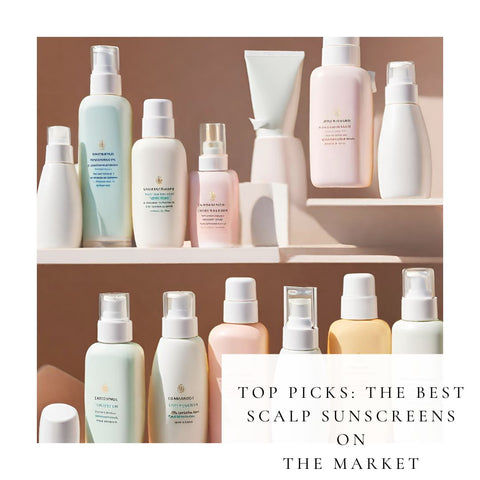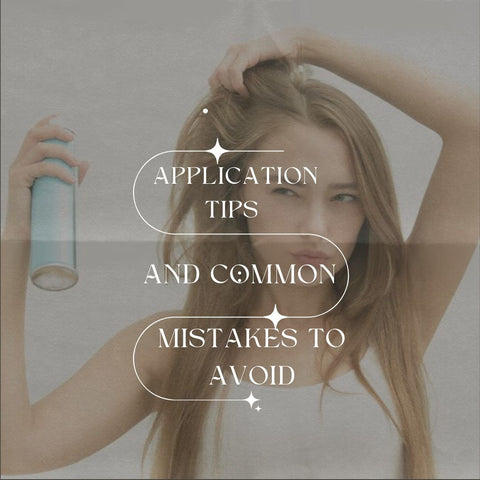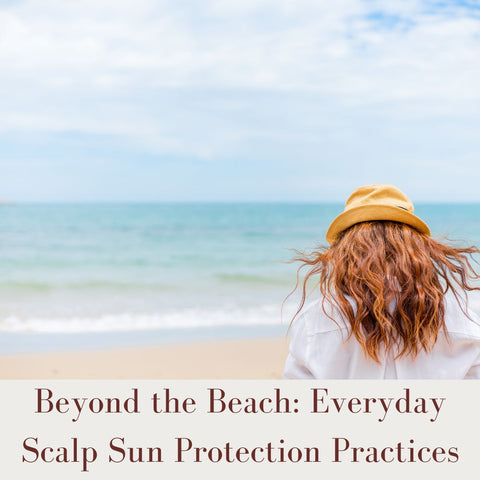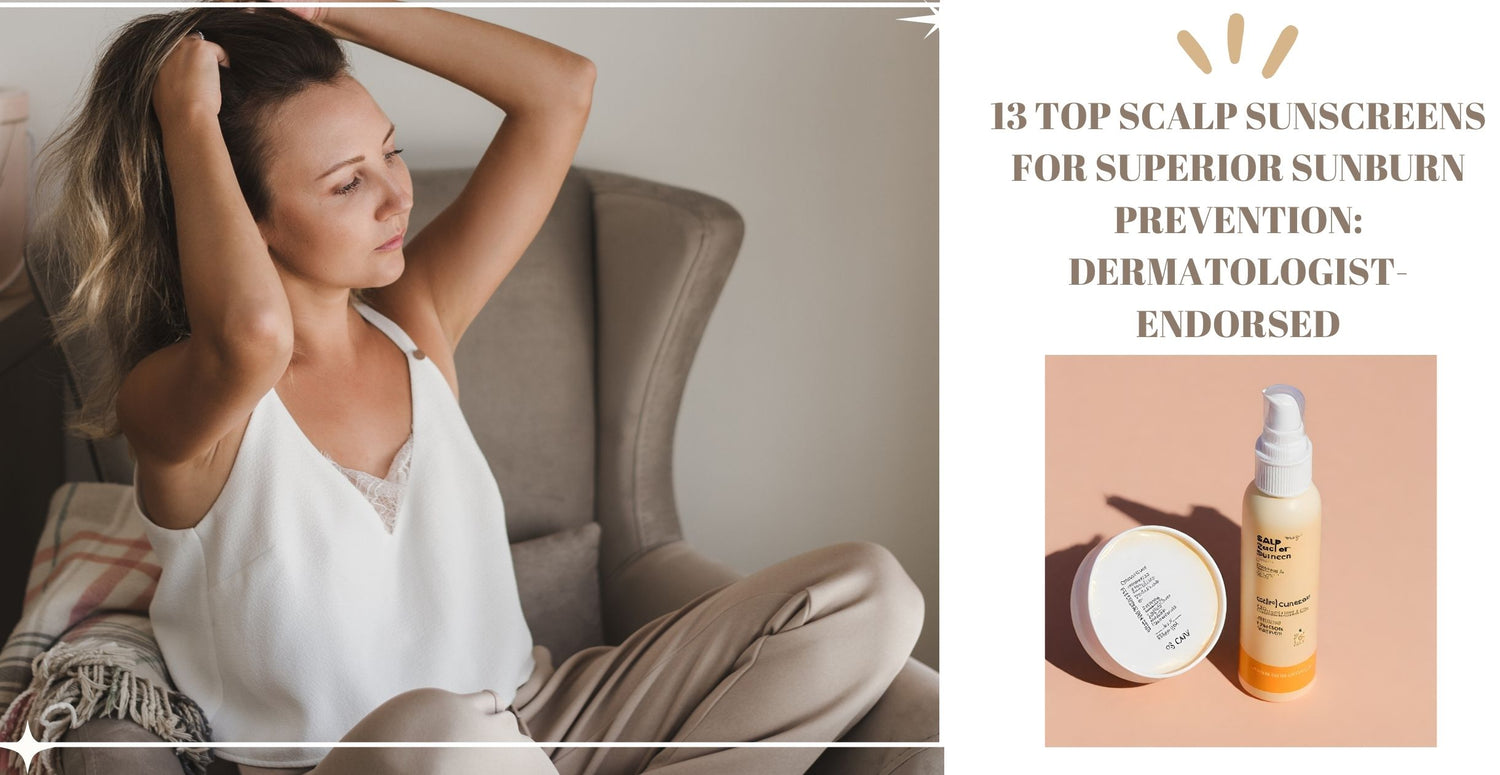Sun protection for your scalp is essential for avoiding sunburn and lowering your risk of developing skin cancer. In this blog, we will look at 13 top scalp sunscreens recommended by dermatologists for effective sunburn prevention.
The Importance of Scalp Sun Protection: What Dermatologists Say

Dermatologists emphasise the importance of scalp sun protection for a variety of reasons, including the prevention of skin cancer, sunburn, hair health, premature ageing, and scalp health. Dermatologists recommend using a scalp-specific sunscreen or applying a broad-spectrum sunscreen with at least SPF 30 to expose scalp areas to effectively protect it from the sun. It is critical to reapply sunscreen regularly, especially if you are sweating or swimming, and to wear protective clothing such as hats or scarves when spending long periods outside. By taking these precautions, you can reduce the risk of sunburn on your scalp while also maintaining healthy skin and hair.
Understanding UV Impact on Scalp and Hair Health
Understanding the effects of UV radiation on scalp and hair health is critical for taking preventative measures to avoid sun damage. Here's an overview of how UV radiation affects the scalp and hair:
-
Scalp Damage: UV radiation can penetrate the skin of the scalp, causing various types of damage:
-
Sunburn: The scalp, like other areas of the skin, is vulnerable to sunburn if not protected. Sunburn to the scalp can result in redness, pain, and peeling.
-
Skin Cancer: Prolonged sun exposure increases the risk of developing scalp skin cancers such as melanoma and squamous cell carcinomas.
-
Hair Damage: UV radiation can also affect the health and appearance of your hair:
-
Dryness and Brittle Hair: UV exposure can strip the hair of its natural oils, resulting in dry, brittle hair that is easy to break.
-
Fading and Discoloration: UV radiation can break down the colour molecules in the hair shaft, resulting in fading and discoloration, particularly in color-treated hair.
-
Split Ends and Frizz: UV damage weakens the protein structure of the hair, making it more prone to split ends, frizz, and damage along the shaft.
-
Chronic Sun Exposure: The ageing process of the scalp and hair can be accelerated:
-
Premature Ageing: UV rays can cause the skin's collagen and elastin fibres to break down, which can result in wrinkles, fine lines, and scalp sagging.
-
Grey Hair: Research indicates that ultraviolet light exposure may have a role in the early onset of grey hair by causing harm to the melanocytes that generate pigment for the hair.
The Criteria for Choosing the Right Scalp Sunscreen
Choosing the right scalp sunscreen is critical for effectively protecting your scalp from sun damage while also ensuring comfort and functionality. Here are some criteria to consider when choosing a scalp sunscreen:
-
Look for sunscreen that provides broad-spectrum protection, which means it blocks both UVA and UVB rays. This provides complete protection from sunburn, skin ageing, and the risk of skin cancer.
-
Choose a sunscreen with a high sun protection factor (SPF), preferably SPF 30 or higher. A higher SPF offers better UV protection, lowering the risk of sunburn and skin damage.
-
Choose a water-resistant sunscreen, particularly if you plan to sweat or swim. Water-resistant formulas stick to the scalp better and offer longer-lasting protection, even when exposed to water or sweat.
-
Look for a sunscreen that has a light, non-greasy texture and absorbs quickly into the scalp without leaving a heavy or oily film. This ensures comfort and keeps the sunscreen from weighing down your hair or making it appear greasy.
-
If you have oily or acne-prone skin on your scalp, use a non-comedogenic sunscreen that will not clog pores or worsen existing skin conditions. Non-comedogenic formulas are less prone to causing breakouts or irritation.
-
To reduce the risk of allergic reactions or skin irritation, use a sunscreen that is hypoallergenic and fragrance-free. These formulas are gentle on the skin and appropriate for people who have sensitivities or allergies.
-
Consider whether you prefer a transparent sunscreen that blends seamlessly into your hair or a tinted option that adds coverage and hides any white residue. Tinted sunscreens can also help conceal thinning hair and visible scalp.
-
Choose a sunscreen with long-lasting protection to avoid frequent reapplication. Some sunscreens claim to provide long-lasting protection for up to 80 minutes or more, depending on the level of activity and water or sweat exposure.
-
Look for sunscreens that are dermatologist-approved or endorsed by reputable skincare professionals. These sunscreens have been rigorously tested for safety and efficacy, making them more likely to provide effective sun protection for your scalp.
-
Consider the ease of application when choosing a scalp sunscreen. Look for sunscreen sprays, mists, or aerosols that allow for easy and even coverage, especially for hard-to-reach areas of the scalp.
Safeguarding Sensitive Scalps: Sunscreens for Every Skin Type
To protect a sensitive scalp from the sun, pay special attention to the sunscreen's ingredients and formulation. Here are sunscreen recommendations for various skin types, including sensitive scalps: Sensitive Skin, Oily Scalps, Dry Scalps, Acne-Prone Scalps, Combination Scalps, Mature Scalps, Children's Scalps, Color-Treated Scalps, Those with Scalp Conditions, and All Skin Types. Before applying sunscreen to your scalp, perform a patch test to ensure that there are no adverse reactions or sensitivity. If you experience any discomfort or irritation, stop using the product and seek advice from a dermatologist. By selecting the best sunscreen for your skin type and needs, you can effectively protect your sensitive scalp from the sun's harmful rays while keeping it healthy and comfortable.
Top Picks: The Best Scalp Sunscreens on the Market

Choosing the best scalp sunscreen is dependent on your skin type, preferences, and specific requirements. Here are some of the top scalp sunscreens available on the market:
-
iS Clinical Eclipse SPF 50+
-
BABE Transparent Sunscreen Wet Skin SPF 50
-
Clinikally SunProtect Sunscreen SPF 50/PA+++
-
Heliocare Advanced Sunscreen Protector Solar Gel SPF 50
-
Heliocare 360 Gel Oil-Free Sunscreen Protector Solar Dry Touch SPF 50/PA++++
-
Maskosun Soft Anti-aging Sunscreen Gel SPF 60+ PA++++
-
Palsons Sunmate Max Aqua Gel Sunscreen SPF 100+
-
Photostable Pro+ Hydragel Sunscreen SPF 80+ PA++++
-
iS Clinical LIPROTECT SPF 35
-
Photostable Pro+ Hydragel Sunscreen SPF 80+ PA++++
-
Dermalogica Dynamic Skin Recovery SPF 50
-
UVSkrin SS Silicone Sunscreen Gel SPF 50+
-
Aclaris Photon 360 Hydra Sunscreen Fluid Cream SPF 50+
Spray vs. Lotion: Pros and Cons for Scalp Application
When it comes to applying sunscreen to the scalp, both spray and lotion formulations have their pros and cons. Here is a contrast between the two:
Spray Sunscreen:
Pros:
-
Spray sunscreens are practical and simple to use, particularly on the parts of the scalp that are difficult to reach.
-
Since sprays usually dry quickly, they provide quick, even coverage without leaving a greasy aftereffect.
-
Spray sunscreens are great for people with oily or fine hair because they usually have a lightweight texture that feels less heavy on the scalp.
-
Spray sunscreens do not need to be spread or rubbed on the hands like lotions do, making application less messy.
Cons:
-
There is a risk of inhaling spray sunscreen particles, especially if applied in windy or indoor environments. Inhaling sunscreen ingredients can irritate the respiratory tract.
-
Spray sunscreen can be difficult to apply evenly, especially on the scalp, potentially leaving gaps in protection.
-
Spray sunscreen may run off the scalp, particularly if you sweat or swim, reducing its effectiveness over time.
Lotion Sunscreen:
Pros:
-
Lotion sunscreens allow for more precise application, making it easier to cover the entire scalp.
-
Lotions adhere well to the skin and hair, offering more reliable sunburn and UV protection.
-
Lotion sunscreens frequently include moisturising ingredients that hydrate and nourish the scalp, making them ideal for dry or sensitive skin.
-
Unlike spray sunscreens, there is no chance of inhaling lotion sunscreen particles while applying.
Cons:
-
Lotions have a thicker texture than sprays, which may feel greasy or more noticeable on the scalp, especially for those with oily hair.
-
Lotion sunscreens may take longer to absorb into the scalp, requiring more time to apply and possibly leaving a temporary white cast until fully absorbed.
-
Applying lotion sunscreen to the scalp involves rubbing or massaging it into the skin, which may be less convenient or quick than spray application.
The decision between spray and lotion sunscreen for scalp application is based on personal preference, hair type, and specific requirements. Some people prefer the convenience and light feel of spray sunscreen, whereas others prefer the precision and dependability of lotion sunscreen. Whichever formulation you choose, be sure to apply sunscreen generously and reapply regularly, especially if sweating or swimming, to ensure adequate protection for your scalp.
Natural and Chemical-Free Options for Scalp Care
Several ingredients and products can help maintain scalp health without the use of harsh chemicals for those looking for natural and chemical-free options. Here are a few choices:
-
Coconut Oil: Coconut oil is a natural moisturiser that can hydrate the scalp while also reducing dryness and flaking. Massage coconut oil into your scalp and let it sit for a few hours or overnight before washing with a gentle shampoo.
-
Aloe Vera: Aloe vera has anti-inflammatory and calming qualities that can help soothe irritated scalps and lessen redness and itching. Look for shampoos and conditioners that contain aloe vera extract or apply fresh aloe vera gel straight to the scalp.
-
Tea Tree Oil: Tea tree oil has antimicrobial qualities that can aid in the treatment of acne and dandruff on the scalp. Look for shampoos and scalp treatments that contain tea tree oil, or dilute it with a carrier oil like coconut or olive oil and massage it into the scalp.
-
Apple cider vinegar: A natural clarifying agent, apple cider vinegar can help balance the pH levels of the scalp and help get rid of product buildup. After shampooing, use a solution of equal parts apple cider vinegar and water to rinse your scalp thoroughly.
-
Jojoba Oil: Jojoba oil is a great moisturiser for dry scalp conditions because it closely resembles the natural oils produced by the scalp. Before shampooing, massage jojoba oil into the scalp and let it sit for at least half an hour.
-
Shea Butter: Rich and emollient, shea butter helps hydrate and nourish the hair and scalp. Look for shea butter-based scalp treatments or hair masks, or apply pure shea butter to the scalp and hair for deep hydration.
-
Rosemary Oil: Rosemary oil has stimulating qualities that can aid in enhancing scalp circulation and encouraging hair growth. Look for shampoos and conditioners that contain rosemary oil, or combine a few drops of rosemary oil with a carrier oil and massage it into your scalp.
-
Baking Soda: Baking soda can be used to exfoliate the scalp and get rid of extra oil and dead skin cells. Before shampooing, make a paste out of baking soda and water and gently massage the paste into the scalp.
-
Castor Oil: This nourishing, thick oil has the potential to hydrate the scalp and encourage hair growth. Apply castor oil to the scalp, massage it in, and let it sit overnight before shampooing it out.
-
Green Tea: Antioxidants found in green tea can help calm and shield the scalp from harm from the environment. After making a pot of green tea and letting it cool, rinse your scalp with it after shampooing.
To make sure you do not have any allergic reactions or sensitivities, patch testing is crucial before using natural ingredients for scalp care. Additionally, if you have any underlying scalp conditions or concerns, seek advice from a dermatologist or other medical professional.
Water-Resistant Sunscreens for Active Lifestyles
Water-resistant sunscreens are vital for people with active lifestyles who spend a lot of time outside, especially in the water or when perspiring, as they offer long-lasting protection against UV radiation. Suitable for active lifestyles, the following water-resistant sunscreens are recommended:
-
BABE Pediatric Transparent Sunscreen Wet Skin SPF 50
-
ISDIN Fotoprotector Fusion Water Sunscreen SPF 50
-
Coola Liplux Sunscreen
-
Coola Classic Face Sunscreen SPF 50
-
Uvavo Water Resistant Oil Free Sunscreen Lotion SPF 25 PA+++
When selecting a water-resistant sunscreen for your active lifestyle, look for products that are labelled "water-resistant" for at least 80 minutes and provide broad-spectrum UVA and UVB protection. To ensure effective sun protection, reapply sunscreen regularly, especially after swimming or sweating.
Application Tips and Common Mistakes to Avoid

Proper sunscreen application is essential for effective sun protection. Here are some application tips and common pitfalls to avoid:
Application Tips:
-
Apply sunscreen liberally to all exposed areas of the skin, including the scalp, ears, neck, face, and any other areas not covered by clothing. The general recommendation is to apply about one ounce (enough to fill a shot glass) to the entire body.
-
Apply sunscreen at least 15 minutes before going outside to ensure proper absorption into the skin. Reapply sunscreen every two hours, or more often if swimming or sweating profusely.
-
Do not forget to apply sunscreen to frequently overlooked areas like the tops of the feet, back of the neck, and ears. To protect the lips from sun damage, apply a lip balm with SPF.
-
Choose a broad-spectrum sunscreen with an SPF of 30 or higher to provide adequate UVA and UVB protection. Higher SPF values provide more protection, but no sunscreen can guarantee 100% protection.
-
Apply sunscreen evenly to the skin, ensuring complete coverage without missing any areas. Pay special attention to sunburn-prone areas like the nose, shoulders, and chest.
-
If you are swimming or sweating heavily, towel drying can remove sunscreen, so reapply immediately to maintain protection.
-
UV rays can penetrate clouds, so it's essential to wear sunscreen even on cloudy or overcast days. UV radiation can also reflect off surfaces like water, sand, and snow, increasing exposure.
-
Use sunscreen in combination with protective clothing, hats, and sunglasses for comprehensive sun protection. Clothing with a tight weave offers better protection than loosely woven fabrics.
Common Mistakes to Avoid:
-
Many people don't apply enough sunscreen to achieve the stated SPF level. Using too little sunscreen reduces its effectiveness and can leave the skin vulnerable to sunburn.
-
Sunscreen needs to be reapplied regularly to maintain its effectiveness, especially during prolonged sun exposure, swimming, or sweating. Failure to reapply can lead to inadequate protection and sunburn.
-
Applying sunscreen right before going outdoors doesn't allow enough time for it to absorb into the skin properly. Apply sunscreen at least 15 minutes before sun exposure to ensure adequate protection.
-
It's easy to forget to apply sunscreen to commonly overlooked areas like the scalp, ears, lips, and tops of the feet. Make sure to cover all exposed areas of the body for comprehensive protection.
-
Some people mistakenly believe that SPF alone is sufficient for sun protection. It's essential to use a broad-spectrum sunscreen that protects against both UVA and UVB rays to prevent sunburn, premature aging, and skin cancer.
-
Check the expiration date on your sunscreen and discard any expired products. Expired sunscreen may be less effective and provide inadequate protection.
-
While sunscreen is essential, it should be used in conjunction with other sun protection measures, such as seeking shade, wearing protective clothing, and avoiding peak sun hours.
By following these application tips and avoiding common mistakes, you can ensure proper use of sunscreen and maximize protection against sun damage and skin cancer.
How to Apply Sunscreen to Your Scalp Without Ruining Your Hair
Applying sunscreen to your scalp without damaging your hair requires some caution to avoid greasiness or residue. Here's how to do it successfully:
-
Choose the Right Sunscreen: Look for a sunscreen that is specifically designed for the scalp or has a lightweight, non-greasy formulation. To reduce residue and keep your hair from weighing down, look for sunscreens labelled "oil-free," "non-comedogenic," or "dry-touch."
-
Categorise Your Hair: To facilitate easier access to your scalp, part your hair into sections. To keep the sections apart while applying sunscreen, use clips or hair ties.
-
Apply sparingly: Using your fingertips, lightly massage a small amount of sunscreen into your scalp, paying particular attention to the parts of your scalp that are most exposed to the sun. To avoid buildup and greasiness, do not apply excessive amounts of sunscreen.
-
Use a Brush or Comb: To ensure that sunscreen is applied evenly throughout your scalp and hair, use a clean brush or comb after applying the product. This reduces residue while ensuring complete coverage.
-
Steer Clear of the Roots: When applying sunscreen, focus on the scalp rather than the actual roots of your hair. This keeps your hair from appearing weighed down or oily.
-
Select the Appropriate Time: To prevent residue from getting into your hair strands and to allow the sunscreen to fully absorb, apply it to your scalp before styling your hair. To avoid messing up your hairstyle, wait to apply sunscreen after styling.
-
Powder Formulas: If you prefer a lighter option, use a powder sunscreen designed specifically for the scalp. These formulas are available in powder form and can be applied directly to the scalp with a brush for a quick and clean application.
-
Reapply as Needed: To ensure adequate protection throughout the day, reapply sunscreen to your scalp regularly, especially if you sweat or swim. Use a gentle shampoo to wash your hair and scalp at the end of the day to remove any sunscreen residue.
By following these guidelines, you can effectively protect your scalp from sunburn while maintaining the appearance of your hair. Experiment with various sunscreen formulas and application methods to determine which works best for you and your hair type.
Reapplication Strategies for Long-Term Sun Exposure
Reapplying sunscreen is essential for providing effective sun protection, particularly during prolonged sun exposure. Here are some strategies for reapplying:
-
Set a timer or alarm on your phone to remind you to reapply sunscreen every two hours, or sooner if you are sweating or swimming. This helps you remember to reapply sunscreen throughout the day.
-
If you plan to swim or sweat heavily, use a water-resistant sunscreen. Water-resistant formulas adhere better to the skin and provide longer-lasting protection, but they must be reapplied regularly, particularly after swimming or towel drying.
-
Bring a travel-sized bottle of sunscreen with you so that you can easily reapply it while on the go. Keep it in your purse, beach bag or backpack for easy access during the day.
-
Reapply sunscreen before going outside, especially if you will be spending a long time in the sun. This ensures that you begin with a fresh layer of protection and reduces the likelihood of sunburn and skin damage.
-
Take breaks in the shade during peak sunlight hours, which are typically between 10 a.m. and 4 p.m. This limits your overall sun exposure and allows your skin to rest in between sunscreen applications.
-
Wear protective clothing like hats, sunglasses, and long-sleeved shirts to provide additional coverage and reduce the need for frequent sunscreen reapplication. Clothing with a tight weave offers better protection than loosely woven fabrics.
-
Consider using sunscreen sprays for quick and easy reapplication, especially on hard-to-reach areas like the scalp, back, and shoulders. Spray sunscreens can be applied over makeup and won't disrupt your hairstyle.
-
Focus on reapplying sunscreen to exposed areas of the skin, including the face, neck, arms, and legs. Pay particular attention to areas prone to sunburn, such as the nose, shoulders, and chest.
-
Drink plenty of water throughout the day to stay hydrated and help maintain the health of your skin. Hydrated skin is less prone to sun damage and may require less frequent sunscreen reapplication.
-
Don't forget to protect your lips with sunscreen lip balm and reapply it regularly throughout the day, especially if you'll be spending time outdoors.
Accessorizing for Added Protection: Hats and More
Hats and other protective gear can provide additional sun protection while complementing your sunscreen routine. Wide-brimmed hats, UPF clothing, sunglasses, neck gaiters and scarves, sun hats with neck flaps, UV-protective umbrellas, UV arm sleeves, sun protective gloves, UV-protective face masks, and cooling neck wraps are some options for sun protection accessories. Accessorising with hats and other protective gear can improve your sun protection routine and lower your risk of sunburn, premature ageing, and skin cancer. Choose accessories that offer adequate protection and comfort for your outdoor activities and lifestyle.
Beyond the Beach: Everyday Scalp Sun Protection Practices

Protecting your scalp from the sun's harmful rays is essential not only at the beach but also in everyday life, particularly if you spend a lot of time outside. Wear a hat, use scarves or head wraps, apply sunscreen to your scalp, select protective hairstyles, seek shade, wear protective clothing, avoid tanning beds, and stay hydrated. Incorporating these simple scalp sun protection practices into your daily routine can help reduce the risk of sunburn, skin damage, and skin cancer while keeping your scalp healthy and protected all year.
















